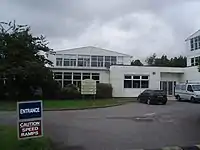Warblington
Warblington, historically part of the Hundred of Bosmere,[1] is a suburb of Havant, a town in Hampshire, England.
| Warblington | |
|---|---|
 An older style house in Warblington, which was partially destroyed by fire in May 2011 | |
 Warblington Location within Hampshire | |
| OS grid reference | SU725065 |
| District | |
| Shire county | |
| Region | |
| Country | England |
| Sovereign state | United Kingdom |
| Post town | HAVANT |
| Postcode district | PO9 |
| Dialling code | 023 |
| Police | Hampshire |
| Fire | Hampshire |
| Ambulance | South Central |
| UK Parliament | |
History
The Saxon settlement at this location, established in the 7th century, is mentioned in the Domesday Book of 1086,[2] indicating a population of about 120.[3] The owner of the property at the time was Roger earl of Shrewsbury; after his death in 1094, it was inherited by his second son, Hugh. Records indicate that the owner in 1186 was William de Courci.[4]
In the 1400s, the people were removed and the area became a private deer park for Richard Neville, 16th Earl of Warwick who then owned the manor.[5][6]
The village was the site of a medieval manor, now known as Warblington Castle built in 1515 and 1525 and mostly destroyed in 1644 during the English Civil War[7] leaving only a single gate tower, part of a wall, and a gateway.[8]
The Imperial Gazetteer of 1870-1872 described Warblington as having a population of 2,196 as of 1861 and mentioned that the "church is Saxon".[9]
There are two church parishes, St Thomas à Becket, Warblington and St James, Emsworth.[10] Pevsner (1967) describes St Thomas à Becket Church as essentially late 12th century and praises the "undisturbed" setting. To the north of the church is the locality's most distinctive landmark: the tall octagonal turret of Warblington Castle. In October 1551, Mary of Guise the widow of James V of Scotland stayed a night in Warblington manor as a guest of Sir Richard Cotton.[11]
Recent times
An old cemetery, the ruins of Grade II listed Warblington Castle, on private property, the Grade I Listed St Thomas à Becket Church, Warblington[12] a Grade II listed Old Farmhouse,[13] and the Grade II listed Old Rectory[14] are all located within the boundaries of the Warblington Conservation Area.[15]
Unusually, Warblington contains a large secondary school (Warblington School)[16] but no primary school.
Warblington railway station is on the West Coastway Line.
Green Pond Corner used to be the local pond. The "corner group" also included Warblington House and Warblington Farm according to records from 1870.[17] The pond was covered over around 1920 and now hosts the One Stop corner shop and local glass and fabric recycling point.
Notable residents
- John Brown (1820-unknown), cricketer born in Warblington
- George Carter (1846-unknown), cricketer
- James Norris, President of Corpus Christi College, Oxford 1843 to 1872
- Sir Peter James Blake KBE (1 October 1948 – 5 December 2001), Sailor, he is buried in the Warblington churchyard
References
- Genuki
- Warblington Conservation Area
- Warblington Castle
- WARBLINGTON Manors
- Lloyd, David W (1974). Buildings of Portsmouth and its Environs. City of Portsmouth. p. 23.
- Warblington Castle
- Barron, William (1985). The Castles of Hampshire & Isle of Wight. Paul Cave Publications. p. 50. ISBN 0-86146-048-0.
- Warblington Castle
- Warblington Hampshire
- Parish web-site
- Calendar State Papers Foreign Edward, London (1861), 190, (PRO SP68/9/85).
- CHURCH OF ST THOMAS-A-BECKET
- WARBLINGTON CASTLE FAMHOUSE
- THE OLD RECTORY
- Warblington Conservation Area
- Warblington School official website
- Section 6.1.2
Bibliography
- Victoria County History A History of the County of Hampshire: Volume 3 Page, W (Ed) 1908 Warblington pp. 134–39
- The Buildings of England: Hampshire & The Isle of Wight, Pevsner, N./Lloyd,D. 1967 Harmondsworth,Penguin ISBN 0-14-071032-9
- Warblington: a village history, Timmins,G. (Havant, Havant Museum, 2007)
Gallery
 1856 etching of castle and church
1856 etching of castle and church Secondary School
Secondary School Tennis Club
Tennis Club Level Crossing
Level Crossing
